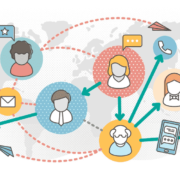Why Senior Living Leads Require MANY More Touches Than Others
Editor’s note: This article was reviewed and updated on 1/21/25.
How many touch points does it take to get a senior living lead to move in? While this number will vary from one community to the next, generally speaking, senior living leads require many touches—likely more than your marketing and sales teams even realize.
In the Enquire Solutions white paper, Marketing Automation Templates for Senior Living, they share a chart about the number of touch points a prospect requires, on average, before becoming a resident.
Turns out, leads need a minimum of 22 touches for independent living, assisted living, and memory care and 28 touches for life plan communities. The sales cycle can range from 107 days (for memory care) to a whopping 400 days (for life plan communities). Assisted living and independent living fall in the middle at 145 days and 203 days, respectively.
The question, of course, is why. Why do senior living leads require so many touch points? And what do your marketing and sales teams need to do as a result?
Why Senior Living Leads Require More Touch Points
Moving, in general, is stressful.
A recent OnePoll survey reported that Americans say moving is the most stressful life event (followed by divorce and marriage). While older adults might recognize that it’s time to move into senior living, the act of moving (and all it entails, like selling their current home) might cause them to stall and stutter along the way.
This is why sales and marketing teams need to be patient and provide those regular touch points. You want your community to be top of mind when the person is finally ready.
Moving into a senior living community is a big monetary investment.
The bigger the price tag on a purchase, the more time people need to evaluate their options and crunch numbers. This is true for any pricey purchase, not just senior living.
Even older adults who have financial stability—for example, they own their own home and have retirement savings—might be skittish about moving into senior living. After all, what if their money runs out?
This is a very real concern. In fact, New Retirement cites a study that claims “60% of baby boomers are more afraid of running out of money than dying.” But here’s the rub—older adults should be worried. The same article shares the following:
- 83 percent of baby boomers in the lowest income quartile will run out of money in retirement
- 47 percent of boomers in the second lowest quartile will run out
- 28 percent of boomers in the second highest quartile will run out
- 13 percent of boomers in the highest income quartile will run out
Providing extra touch points—and including ones that directly address money worries—is a smart way to reassure prospects and move them down the funnel.
Choosing a senior living community is one of the most emotional purchases a person (or family) will ever make.
When a person buys their first home, emotions can run the gamut, but excitement and pride tend to top the list. When a person is shopping around for senior living, the emotions they experience are understandably different. While some people might feel excited about the next chapter, especially if they’re recently retired and entering into independent living, others might have mixed feelings:
A sense of loss about leaving their home (often the one where they raised their family)
- Monetary concerns (will they outlive their funds?)
- Fears around declining health
- Existential angst (facing their own mortality)
Given what so many senior living leads are dealing with, it’s no wonder they need time to process, consider their options, and engage numerous times with communities before making a decision.
Our job as senior living marketers is to patiently accompany them on this journey of contemplation and discovery. The goal of ongoing communications shouldn’t be to sell, sell, sell, but rather to give, give, give. Give prospects information that will truly help them.
Strategies for Creating a Multi-Touch Lead Nurturing Campaign
Here’s what you need to keep in mind as you nurture your leads over the long haul.
If you haven’t already, invest in marketing automation. You can’t do effective lead nurturing without quality marketing automation. Full stop. It’s important to choose the right marketing automation for your community’s specific needs and budgets. If you need help selecting software, call us.
Make sure you set up lead scoring. Not all leads are created equal. Some leads will be more sales-qualified than others. The sales-qualified leads (SQLs) will be served up to the sales team for follow-up. The marketing-qualified leads (MQLs) will enter your long-term lead nurturing programs.
Understand your prospective buyers. In addition to the pain points outlined above, your prospects might have other pain points as well. Remember, you’re selling to various people, including older adults, spouses, adult children, and so forth. You need to create lead nurturing for each persona.
Map out different journeys and create content that will be helpful throughout each journey. For example, if your prospects are getting “stuck” because of concerns over money, develop content that acknowledges their fears and that offers potential solutions. Some examples . . .
- Provide a short guide on the Veterans Aid and Attendance Benefit and a checklist that helps the person self-qualify.
- Create and share short videos from current residents who had similar money concerns—and what helped them feel good about choosing your community.
- Give authentic answers to tough questions. You could create a guide called “Retirement Worries: What Happens if Your Money Runs Out?”
- Offer a complimentary lunch & learn with your community’s financial counselor.
You get the idea. When you approach your lead nurturing from a problem/solution perspective (rather than a sell, sell, sell perspective), developing helpful content for 22+ emails isn’t as challenging as you might think.
That said, if you get stuck with all the touch points, let us help.
Too often, communities simply go through the motions when it comes to creating and sending automated emails. That approach won’t get you the results you want. Reach out and let’s discuss a sound strategy for creating a multi-touch nurturing campaign that turns prospects into move-ins over the long haul.





